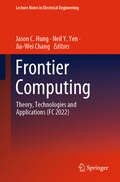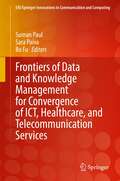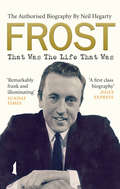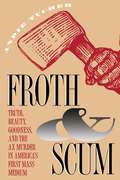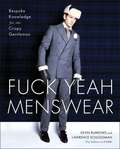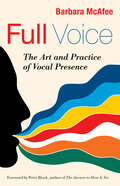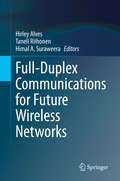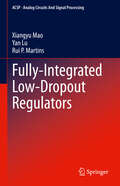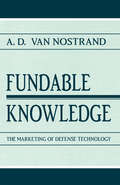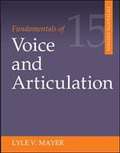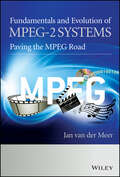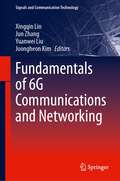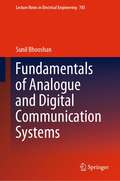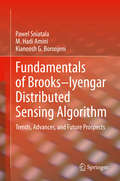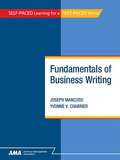- Table View
- List View
Frontier Computing: Theory, Technologies and Applications (FC 2022) (Lecture Notes in Electrical Engineering #1031)
by Neil Y. Yen Jason C. Hung Jia-Wei ChangThis book gathers the proceedings of the 12th International Conference on Frontier Computing, held in Tokyo, Japan, on July 12–15, 2022, and provides comprehensive coverage of the latest advances and trends in information technology, science, and engineering. It addresses a number of broad themes, including communication networks, business intelligence and knowledge management, Web intelligence, and related fields that inspire the development of information technology. The respective contributions cover a wide range of topics: database and data mining, networking and communications, Web and Internet of things, embedded systems, soft computing, social network analysis, security and privacy, optical communication, and ubiquitous/pervasive computing. Many of the papers outline promising future research directions, and the book benefits students, researchers, and professionals alike. Further, it offers a useful reference guide for newcomers to the field.
Frontiers of Data and Knowledge Management for Convergence of ICT, Healthcare, and Telecommunication Services (EAI/Springer Innovations in Communication and Computing)
by Bo Fu Sara Paiva Suman PaulThis book provides a range of application areas of data and knowledge management and their solutions for the fields related to the convergence of information and communication technology (ICT), healthcare, and telecommunication services. The authors present approaches and case studies in future technological trends and challenges in the aforementioned fields. The book acts as a scholarly forum for researchers both in academia and industry.
Frontiers of Management: Research and Practice (Routledge Revivals)
by Roger MansfieldThis edited collection, first published in 1989, stems from the second annual meeting of the British Academy of Management, held at Cardiff Business School in 1988. With the focus on important areas of change affecting management practice and theory – in markets, technology and organizational structure - this volume contains a selection of material presented at the conference by leading scholars in the field. Their contributions provide multi-disciplinary views of organizational strategy, across a wide spectrum of business and industry, which will be of significant interest to any students of business structure and management.
Frost/Nixon: Behind the Scenes of the Nixon Interviews
by David Frost Bob ZelnickThe British journalist recounts his 1977 interview with the disgraced American president—the basis for the Tony Award–winning play & Oscar-nominated film.In Frost/Nixon, Sir David Frost tells the extraordinary story of how he pursued and landed the biggest fish of his career—and how the series drew larger audiences than any news interview ever had in the United States, before being shown all over the world.This is Frost’s absorbing story of his pursuit of Richard Nixon, and is no less revealing of his own toughness and pertinacity than of the ex-President’s elusiveness. Frost’s encounters with such figures as Swifty Lazar, Ron Ziegler, potential sponsors, and Nixon as negotiator are nothing short of hilarious, and his insight into the taping of the programs themselves is fascinating.Frost/Nixon provides the authoritative account of the only public trial that Nixon would ever have, and a revelation of the man’s character as it appeared in the stress of eleven grueling sessions before the cameras. Including historical perspective and transcripts of the edited interviews, this is the story of Sir David Frost’s quest to produce one of the most dramatic pieces of television ever broadcast, described by commentators at the time as “a catharsis” for the American people.
Frost: The Authorised Biography
by Neil HegartySir David Frost was the only person to have met and interviewed every British Prime Minister since Harold Wilson as well as seven Presidents of the United States. With unparalleled, authorised access to David’s family and friends, in this book Neil Hegarty documents how he became the most successful TV host in the world, his work defining the mood of the moment.Frost didn’t just report the news, he made the news.
Froth and Scum
by Andie TucherTwo notorious antebellum New York murder cases--a prostitute slashed in an elegant brothel and a tradesman bludgeoned by the brother of inventor Samuel Colt--set off journalistic scrambles over the meanings of truth, objectivity, and the duty of the press that reverberate to this day. In 1833 an entirely new kind of newspaper--cheap, feisty, and politically independent--introduced American readers to the novel concept of what has come to be called objectivity in news coverage. The penny press was the first medium that claimed to present the true, unbiased facts to a democratic audience. But in Froth and Scum, Andie Tucher explores--and explodes--the notion that 'objective' reporting will discover a single, definitive truth. As they do now, news stories of the time aroused strong feelings about the possibility of justice, the privileges of power, and the nature of evil. The prostitute's murder in 1836 sparked an impassioned public debate, but one newspaper's 'impartial investigation' pleased the powerful by helping the killer go free. Colt's 1841 murder of the tradesman inspired universal condemnation, but the newspapers' singleminded focus on his conviction allowed another secret criminal to escape. By examining media coverage of these two sensational murders, Tucher reveals how a community's needs and anxieties can shape its public truths. The manuscript of this book won the 1991 Allan Nevins Prize of the Society of American Historians for the best-written dissertation in American history. from the book Journalism is important. It catches events on the cusp between now and then--events that still may be changing, developing, ripening. And while new interpretations of the past can alter our understanding of lives once led, new interpretations of the present can alter the course of our lives as we live them. Understanding the news properly is important. The way a community receives the news is profoundly influenced by who its members are, what they hope and fear and wish, and how they think about their fellow citizens. It is informed by some of the most occult and abstract of human ideas, about truth, beauty, goodness, and justice.
Fuck Yeah Menswear
by Kevin Burrows Lawrence SchlossmanIn your hands is an Amazonian blowgun full of deadly knowledge darts ready to be delivered straight to your cranium. You're about to begin a journey that will end in only one way--with you standing naked in an abandoned ravine watching as your old wardrobe slowly burns. Let this be your illustrated Iliad for dressing better. Don't sleep. Read Fuck Yeah Menswear. Refer to it. Cite it in your dissertation. Owning this book sends a very clear message to your peers, coworkers, and loved ones: "I'm trill as fuck."where the authors humorously discuss and dissect the finer points of the menswear world and the habits of the masculine fashion enthusiast. With biting breakdowns of must-have wardrobe essentials, the nuances of owning one's look, and the importance of living a "lifestyle," it's the hippest handbook available for any aspiring sartorialist.
Full Voice: The Art and Practice of Vocal Presence
by Barbara McAfee"Your voice matters. Based on your tone and expression alone listeners make up their minds about you before they even process the meaning of your words. And if what you say is at odds with how you say it, they can miss your message altogether. Barbara McAfee offers a fun, tested method to harness the power of your voice to become a more effective and flexible communicator. She identifies five distinct vocal sounds—earth, fire, water, metal, and air—explaining how to cultivate each one. You’ll learn how to use your voice to support the meaning and message you want to convey. Using this book along with her free online practice videos you’ll experience an authentic shift in how you express yourself – and how you listen to others as well. You’ll discover how opening your full voice connects you to sources of untapped potential, power, and aliveness. "
Full-Duplex Communications for Future Wireless Networks
by Himal A. Suraweera Hirley Alves Taneli RiihonenThis book focuses on the multidisciplinary state-of-the-art of full-duplex wireless communications and applications. Moreover, this book contributes with an overview of the fundamentals of full-duplex communications, and introduces the most recent advances in self-interference cancellation from antenna design to digital domain. Moreover, the reader will discover analytical and empirical models to deal with residual self-interference and to assess its effects in various scenarios and applications. Therefore, this is a highly informative and carefully presented book by the leading scientists in the area, providing a comprehensive overview of full-duplex technology from the perspective of various researchers, and research groups worldwide. This book is designed for researchers and professionals working in wireless communications and engineers willing to understand the challenges and solutions full-duplex communication so to implement a full-duplex system.
Fully-Integrated Low-Dropout Regulators (Analog Circuits and Signal Processing)
by Yan Lu Xiangyu Mao Rui P. MartinsThis book discusses in detail the key specifications of fully integrated low-dropout regulators (LDOs). It covers the various LDO architectures, including the classic analog architectures and the state-of-the-art digital and switching control methods. The design insight and comparison are discussed according to the key performance index. Readers will be enabled to find a suitable architecture when designing a fully integrated LDO.
Fun and Games: My 40 Years Writing Sports
by Dave Perkins&“Covering many of the biggest names and greatest events in sports, it&’s a wonderful collection of yarns and reminiscences, told in Perk&’s inimitable style&” (Postmedia News). Dave Perkins was once told by a bluntly helpful university admissions officer: &“You don&’t have the looks for TV or the voice for radio. You should go into print.&” Which he did, first at the Globe and Mail, and then for thirty-six well-traveled years at the Toronto Star. In Fun and Games, Perkins recounts hysterical, revealing, and sometimes embarrassing personal stories from almost every sport and many major championships. After forty years of encountering a myriad of athletes, fans, team managers, and owners, Perkins offers unique observations on the Blue Jays and Raptors, fifty-eight major championships&’ worth of golf, ten Olympic Games, football, hockey, boxing, horse racing, and more. Learn why Tiger Woods asked Perkins if he was nuts, why he detected Forrest Gump in the 1996 Atlanta Olympics, and why Super Bowl week is the worst week of the year. Perkins exposes the mistakes he made in both thought and word—once, when intending to type &“the shot ran down the goalie&’s leg,&” he used an &“i&” instead of an &“o&”—and to this day, he has never found a sacred cow that didn&’t deserve a barbecue. &“Few can spin a yarn with the wit and clever turns of phrase that Perky can.&” —Shi Davidi, Sportsnet &“Anyone who has ever spoken to Dave Perkins, or read Dave Perkins, remembers his voice. This book is a delightful way to experience it all again, through the wise, funny man&’s eyes.&” —Bruce Arthur, Toronto Star sports columnist
Functional Approach to Professional Discourse Exploration in Linguistics
by Elena N. MalyugaThis book presents research into various types of professional discourse through the prism of the functional linguistics approach. Focusing mainly on practical aspects of speech, the book discusses various topics, such as structural, semantic, cognitive and pragmatic characteristics of professional discourse, argumentation strategies, humour in professional discourse, and word-building processes. It also highlights communicative effectiveness methods in professional discourse. Offering new ideas and discussing the latest findings, the book is intended for researchers, lecturers and professionals in the field.
Functional Encryption (EAI/Springer Innovations in Communication and Computing)
by Khaleel Ahmad Uma N. Dulhare Khairol Amali Bin AhmadThis book provides awareness of methods used for functional encryption in the academic and professional communities. The book covers functional encryption algorithms and its modern applications in developing secure systems via entity authentication, message authentication, software security, cyber security, hardware security, Internet of Thing (IoT), cloud security, smart card technology, CAPTCHA, digital signature, and digital watermarking. This book is organized into fifteen chapters; topics include foundations of functional encryption, impact of group theory in cryptosystems, elliptic curve cryptography, XTR algorithm, pairing based cryptography, NTRU algorithms, ring units, cocks IBE schemes, Boneh-Franklin IBE, Sakai-Kasahara IBE, hierarchical identity based encryption, attribute based Encryption, extensions of IBE and related primitives, and digital signatures.Explains the latest functional encryption algorithms in a simple way with examples;Includes applications of functional encryption in information security, application security, and network security;Relevant to academics, research scholars, software developers, etc.
Fund Raising and Public Relations: A Critical Analysis (Routledge Communication Ser.)
by Kathleen S. KellyThis is the first scholarly work to place the function of fund raising within the field of public relations, redefining it as a specialization responsible for the management of communication between a charitable organization and its donor publics. Combining her academic interest in communication with her experience as a fund raiser, the author has produced one of the few critical studies on fund raising, challenging current perspectives and employing systems theory and the concept of organizational autonomy to lead to a new and different approach. Until now, fund raising has been an anomaly, without an academic home and with few general theories to guide practitioner behavior. This book theoretically grounds fund raising and develops a theory that provides a fuller understanding of one of the fastest growing occupations in the nonprofit sector.
Fundable Knowledge: The Marketing of Defense Technology (Rhetoric, Knowledge, and Society Series)
by A.D. Van NostrandKnowledge is the basic output of the defense technology establishment in the United States; it is what enables the development of weapon systems. From this premise, this volume explores the process of knowledge production in defense technology from the beginnings of the Cold War to the present time. Produced through the process of research and development (R&D), technical knowledge for defense is an economic commodity. It is "fundable" in the sense of having future value. Like other commodities in the futures market, it is purchased before it is produced. But unlike those other commodities, this knowledge is typically produced through the joint efforts of the customer and the vendor. This study highlights two polar aspects of knowledge production: technology development and technology transfer. It centers on the present, shifting concept of defense conversion that is redefining defense technology policy. The book also includes cited documents pertaining to the transactions that engage customers and vendors in the process of knowledge production. The documents constitute a literature of needs and claims, and they reveal two chief properties: problem formulation and tactical positioning. Apart from the substantive yield of these particular documents, the strategy of evidence in this volume has broad implications for further study, suggesting a means of analyzing knowledge production in other large social systems.
Fundamental Research in Electrical Engineering: The Selected Papers of The First International Conference on Fundamental Research in Electrical Engineering (Lecture Notes in Electrical Engineering #480)
by Shahram Montaser KouhsariThis volume presents the selected papers of the First International Conference on Fundamental Research in Electrical Engineering, held at Khwarazmi University, Tehran, Iran in July, 2017. The selected papers cover the whole spectrum of the main four fields of Electrical Engineering (Electronic, Telecommunications, Control, and Power Engineering).
Fundamentals 0f Investigative Report Writing
by Gary GuthrieThis book teaches readers how to precisely construct investigative reports, whether for criminal, employment-policy, or employee-performance investigations. <p><p>Dedicated to helping report-writers produce valuable extrinsic documentation, the book explains how to describe "what happened and why" in clear, concise terms. Topics include writing attitude and ethics, the "always" rules of writing, tips for conducting successful interviews, techniques for writing with precision, purposes and techniques for editing and proof-reading, and how to incorporate sketches, drawings, diagrams, and other visuals. The book also addresses considerations when writing United States Constitutional- based reports, as well as strategies involved in other forms of written communication such as e-mail, business letters, memoranda, and social media. <p><p>This edition features a chapter devoted to performance evaluations that helps supervisors to be accurate, state things efficiently, insure the quality of the organization, and develop the employee. Each chapter includes learning objectives, chapter summaries, specific writing assignments, and a feature story related to the chapter's content-focus. Illustrations have been carefully selected to support the written text. <p><p>Thoughtfully developed to set students and instructors up for success, Fundamentals of Investigative Report Writing is ideal for technical education programs in administration of justice, criminal justice, and law enforcement and courses on investigative and police report writing and report writing for criminal justice and law enforcement professionals.
Fundamentals Of Voice And Articulation
by Lyle MayerFor more than fifty years, Fundamentals of Voice and Articulation has helped students develop effective voice and speech habits with its amusing exercises and lively practice material.
Fundamentals and Evolution of MPEG-2 Systems
by Jan Van der MeerThis book describes the fundamentals and details of MPEG-2 Systems technologyWritten by an expert in the field, this book examines the MPEG-2 system specification as developed in the early 1990's, as well as its evolution into the fourth edition of the MPEG-2 systems standard, published in 2013. While MPEG-2 systems will continue to evolve further, this book describes the MPEG-2 system functionality as of October 2013. Furthermore, relevant background information is provided. The discussion of MPEG-2 system functionality requires knowledge of various fundamental issues, such as timing, and supported content formats. Therefore also some basic information on video and audio coding is provided, including their evolution. Also other content formats supported in MPEG-2 systems are described, as far as needed to understand MPEG-2 systems.Ordered logically working from the basics and background through to the details and fundamentals of MPEG-2 transport streams and program streamsExplores important issues within the standardization process itselfPuts the developments on MPEG-2 systems into historic perspectiveIncludes support of 3D Video and transport of AVC, SVC and MVCConcludes with additional issues such as real-time interface, delivery over IP networks and usage by application standardization bodiesPredicts a continuing promising future for MPEG-2 transport streams
Fundamentals and Principles of Electromagnetic Wave Absorbers: From Theory, Design, and Materials to Measurement (Springer Series in Advanced Microelectronics #66)
by Sung-Soo KimThis book consists of three main parts: fundamental theory, design principles and methodology, and potential materials that can be applied to EM wave absorbers. In the theory part, this book provides the basics of electromagnetism, circuit and transmission line theory, EM wave propagation and reflection, and complex permittivity and permeability by electric polarization and magnetization of materials. In the design part, design methods are explained for various types of EM wave absorbers based on equivalent circuit models and simulation technologies. Starting from the traditional resonance-type absorber, this book reviews the latest metamaterial and frequency selection surface (FSS) absorbers with more advanced design techniques. Recent research results are also included associated with how to design the ultrawide-bandwidth absorbers through multilayering FSSs or shape-control of lossy materials. In the materials section, various lossy materials are reviewed that can be used as EM wave absorbers, including conductive materials, magnetic materials, dielectric materials, core-shell materials, fiber-reinforced composite materials, and metamaterials or metasurfaces. Literature reviews on their electromagnetic properties and EM wave absorption performance are also presented. Finally, the methods and principles for measuring the high-frequency properties (complex permittivity and permeability) and EM wave absorption are described.
Fundamentals of 6G Communications and Networking (Signals and Communication Technology)
by Jun Zhang Yuanwei Liu Xingqin Lin Joongheon KimThis book begins with a historical overview of the evolution of mobile technologies and addresses two key questions: why do we need 6G? and what will 6G be? The remaining chapters of this book are organized into three parts: Part I covers the foundation of an end-to-end 6G system by presenting 6G vision, driving forces, key performance indicators, and societal requirements on digital inclusion, sustainability, and intelligence. Part II presents key radio technology components for the 6G communications to deliver extreme performance, including new radio access technologies at high frequencies, joint communications and sensing, AI-driven air interface, among others. Part III describes key enablers for intelligent 6G networking, including network disaggregation, edge computing, data-driven management and orchestration, network security and trustworthiness, among others. This book is relevant to researchers, professionals, and academics working in 5G/6G and beyond.
Fundamentals of Analogue and Digital Communication Systems (Lecture Notes in Electrical Engineering #785)
by Sunil BhooshanThe book covers fundamentals and basics of engineering communication theory. It presents right mix of explanation of mathematics (theory) and explanation. The book discusses both analogue communication and digital communication in details. It covers the subject of ‘classical’ engineering communication starting from the very basics of the subject to the beginning of more advanced areas. It also covers all the basic mathematics which is required to read the text. It covers a two semester course as an undergraduate text and some topics in master’s course as well.
Fundamentals of Brooks–Iyengar Distributed Sensing Algorithm: Trends, Advances, and Future Prospects
by Kianoosh G. Boroojeni M. Hadi Amini Pawel SniatalaThis book provides a comprehensive analysis of Brooks-Iyengar Distributed Sensing Algorithm, which brings together the power of Byzantine Agreement and sensor fusion in building a fault-tolerant distributed sensor network. The authors analyze its long-term impacts, advances, and future prospects. The book starts by discussing the Brooks-Iyengar algorithm, which has made significant impact since its initial publication in 1996. The authors show how the technique has been applied in many domains such as software reliability, distributed systems and OS development, etc. The book exemplifies how the algorithm has enhanced new real-time features by adding fault-tolerant capabilities for many applications. The authors posit that the Brooks-Iyengar Algorithm will to continue to be used where fault-tolerant solutions are needed in redundancy system scenarios.This book celebrates S.S. Iyengar's accomplishments that led to his 2019 Institute of Electrical and Electronics Engineers' (IEEE) Cybermatics Congress "Test of Time Award" for his work on creating Brooks-Iyengar Algorithm and its impact in advancing modern computing.
Fundamentals of Business Writing
by Joseph C. Mancuso Yvonne V. ChabrierA ground-breaking approach to writing with a greater focus on planning and revising documents. When you complete this book, you will know how to write with clarity and style, so your ideas come across clearly and quickly. You’ll become a sharp-eyed critic, constantly spurring yourself to do better. Best of all, you’ll learn by doing—by building and evaluating your own business letter. You’ll discover how to avoid writer's block by making writing a process with a beginning, middle, and end. You will learn how to: • Sharpen your competitive edge through good, clear writing • Make sure your written words say exactly what you mean • Identify words and phrases that get in the way of clear, concise communication • Quickly analyze, organize, write, and revise any document • Use expressive words; keep sentences and paragraphs short; keep thoughts simple • Use techniques that involve the reader and create the feeling of personal communication • Format documents so they're inviting to look at and easy to read
Fundamentals of Cognitive Radio
by Simon Haykin Peyman SetoodehA comprehensive treatment of cognitive radio networks and the specialized techniques used to improve wireless communications The human brain, as exemplified by cognitive radar, cognitive radio, and cognitive computing, inspires the field of Cognitive Dynamic Systems. In particular, cognitive radio is growing at an exponential rate. Fundamentals of Cognitive Radio details different aspects of the human brain and provides examples of how it can be mimicked by cognitive dynamic systems. The text offers a communication-theoretic background, including information on resource allocation in wireless networks and the concept of robustness. The authors provide a thorough mathematical background with data on game theory, variational inequalities, and projected dynamic systems. They then delve more deeply into resource allocation in cognitive radio networks. The text investigates the dynamics of cognitive radio networks from the perspectives of information theory, optimization, and control theory. It also provides a vision for the new world of wireless communications by integration of cellular and cognitive radio networks. This groundbreaking book: Shows how wireless communication systems increasingly use cognition to enhance their networks Explores how cognitive radio networks can be viewed as spectrum supply chain networks Derives analytic models for two complementary regimes for spectrum sharing (open-access and market-driven) to study both equilibrium and disequilibrium behaviors of networks Studies cognitive heterogeneous networks with emphasis on economic provisioning for resource sharing Introduces a framework that addresses the issue of spectrum sharing across licensed and unlicensed bands aimed for Pareto optimality Written for students of cognition, communication engineers, telecommunications professionals, and others, Fundamentals of Cognitive Radio offers a new generation of ideas and provides a fresh way of thinking about cognitive techniques in order to improve radio networks.
